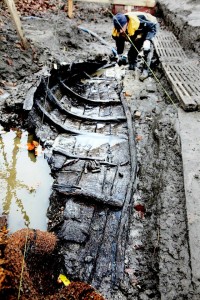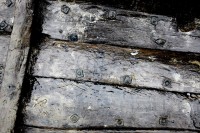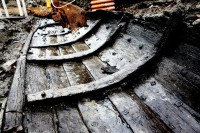 Archaeologists excavating the site of a moat around the ruins of Vordingborg Castle on the southeastern Danish island of Zealand have unearthed the well-preserved remains of rowboat that dates to around 1400. This is the only medieval boat ever discovered in Denmark. The team stumbled on it unexpectedly when they were doing some sewer work on the ruins. They saw a plank peek through the mud and then further excavation revealed that it was an almost intact rowboat in an exceptional state of preservation.
Archaeologists excavating the site of a moat around the ruins of Vordingborg Castle on the southeastern Danish island of Zealand have unearthed the well-preserved remains of rowboat that dates to around 1400. This is the only medieval boat ever discovered in Denmark. The team stumbled on it unexpectedly when they were doing some sewer work on the ruins. They saw a plank peek through the mud and then further excavation revealed that it was an almost intact rowboat in an exceptional state of preservation.
The boat was found on its starboard side. Only two of the starboard planks remain intact on the side, although sections of starboard planks three and four are preserved in the stern. The bow is missing. Archaeologists estimate that it was originally about 6.5 meters (21 feet) long. It is clinker-built, an ancient Nordic shipbuilding technique wherein the hull is constructed using overlapping planks joined with iron nails. The Vikings made their terror-striking longships using the clinker technique, and it was the most used method of shipbuilding in northern Europe from the 9th century to the 19th.
 According to excavation leader Lars Sass Jensen, dendrochronological analysis (tree-ring dating) found that the trees used to make the boat were cut down in 1390. The boat would have been put to work in the castle moat shortly thereafter. There it remained for many years.
According to excavation leader Lars Sass Jensen, dendrochronological analysis (tree-ring dating) found that the trees used to make the boat were cut down in 1390. The boat would have been put to work in the castle moat shortly thereafter. There it remained for many years.
Although today we think of moats as a purely defensive feature of a castle, they were also put to practical use. Many moats contained fish traps, underwater fences used to coral and capture fish. The rowboat could have been used to maintain the fish traps or people might have fished directly from the boat. It could also have been something of a mini pleasure barge, used by the aristocratic inhabitants of the castle and their guests to go for gentle rows along the moat.
Whatever its functions, evidence indicates that the little vessel lives a long, fruitful life on the moat.
Despite its old age, the boat from Vordingborg is incredibly well-preserved. That has enabled the archaeologists to see that the six-metre-long rowboat has had a long life. It’s been patched and repaired over and over again.
“The rowboat is almost fully preserved. The only thing missing is a little section of one side and the part that the excavator broke off when we found the boat,” says Jensen.
“Because it’s so well-preserved, we can see that many repairs have been made on it, and that the keel is highly worn.”
 The repairs and wear pattern suggest it was used for generations. There’s no clear cause of death, if you will, that might explain how the old rowboat wound up on the bottom of the moat never to be recovered. Larsen speculates that it might have sprung a leak and sunk during the cold of winter when it would be more chilling trouble to attempt to rescue the aged thing than to simply let it rest in peace in an appropriately watery grave.
The repairs and wear pattern suggest it was used for generations. There’s no clear cause of death, if you will, that might explain how the old rowboat wound up on the bottom of the moat never to be recovered. Larsen speculates that it might have sprung a leak and sunk during the cold of winter when it would be more chilling trouble to attempt to rescue the aged thing than to simply let it rest in peace in an appropriately watery grave.
Their trash is Denmark’s and the castle’s treasure since they now have a lovely and unique medieval boat to study. The rowboat has been removed from the site and is now being kept in a water bath to keep it from drying, cracking and decaying before it is restored for display at the new Danish Castle Centre which is scheduled to open in the summer of 2013.
 Vordingborg Castle was built in the late 12th century by King Valdemar I who used it for defense and also as a launching pad for raids against the German coat. Subsequent kings expanded it until at its peak in the late 14th century under King Valdemar IV it had a massive defensive wall 2,600 feet long dotted with nine towers. Much of the castle was demolished in the 17th century to make an elegant palace for Prince George, son of King Frederick III of Denmark and Norway and prince consort of Queen Anne of Britain. George never lived in that palace and in the 18th century it was demolished too. All that remains standing of the largest royal castle in Denmark today are parts of the 14th century ring wall and one of the nine towers (today known as the Goose Tower after the golden goose placed on its roof in the 19th century).
Vordingborg Castle was built in the late 12th century by King Valdemar I who used it for defense and also as a launching pad for raids against the German coat. Subsequent kings expanded it until at its peak in the late 14th century under King Valdemar IV it had a massive defensive wall 2,600 feet long dotted with nine towers. Much of the castle was demolished in the 17th century to make an elegant palace for Prince George, son of King Frederick III of Denmark and Norway and prince consort of Queen Anne of Britain. George never lived in that palace and in the 18th century it was demolished too. All that remains standing of the largest royal castle in Denmark today are parts of the 14th century ring wall and one of the nine towers (today known as the Goose Tower after the golden goose placed on its roof in the 19th century).
The castle’s Facebook page has a neat collection of photographs of the excavation and removal of the boat, plus pictures of other finds like the collapsed brick tower mentioned in the article.
Given the challenges of preserving the Vasa and other long-underwater wooden ships since recovered, I wonder what approach will be taken towards protection of this craft in order to allow it to be displayed. Maybe it’ll be kept in a large tank of water! 🙂